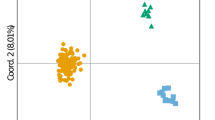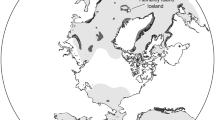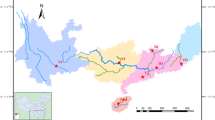Abstract
The long-snouted seahorse Hippocampus guttulatus is one of the two European seahorse species. We describe the isolation of the first 12 microsatellite loci in this threatened species. These new markers were tested in non-invasive samples of 32 seahorses from NW Spain. The number of alleles ranged from 2 to 15 (mean: 6.3) and expected heterozygosity from 0.031 to 0.912 (mean: 0.500). All loci conformed to Hardy–Weinberg expectations and no genotypic disequilibrium was observed between any pair of loci. The theoretical exclusion probabilities for this set of loci, when no parental information exists or when one parent is known, were 0.973 and 0.998, respectively. This study indicates the usefulness of these novel loci for population analysis and kinship studies in Hippocampus guttulatus. Their potential application is extended to the other European seahorse species, since all loci were successfully cross-amplified in H. hippocampus.
Similar content being viewed by others
References
Avise JC, Jones AG, Walker D et al. (2002) Genetic mating systems and reproductive natural histories of fishes: lessons for ecology and evolution. Annu Rev Genet 36:19–45
Carreras-Carbonell J, Macpherson E, Pascual M (2004) Isolation and characterization of microsatellite loci in Tripterygion delaisi. Mol Ecol Notes 4:438–439
Castro J, Bouza C, Presa P, Pino-Querido A et al. (2004) Potential sources of error in parentage assessment of turbot (Scophthalmus maximus) using microsatellite loci. Aquaculture 242:119–135
CITES (2002) Convention on International trade in endangered species of wild fauna and flora. Twelth Meeting of the Conference of the Parties, Santiago de Chile, Chile, 3–15 November
Ellegren H (2004) Microsatellites: simple sequences with complex evolution. Nat Rev Genet 5:435–445
Estoup A, Largiadèr CR, Perrot E et al. (1996) Rapid one-tube DNA extraction for reliable PCR detection of fish polymorphic markers and transgenes. Mol Mar Biol Biotechnol 5:295–298
IUCN (2006) 2006 IUCN red list of threatened species.<www.iucnredlist.org>. Cited 26 September 2006
Marshall TC, Slate J, Kruuk LEB et al. (1998) Statistical confidence for likelihood-based paternity inference in natural populations. Mol Ecol 7:639–655
Pardo BG, Hermida M, Fernández C, Bouza C, Perez M, Llavona A, Sanchez L, Martinez P (2006) A set of highly polymorphic microsatellites useful for kinship and population analysis in turbot (Scopthalmus maximus L). Aquac Res. DOI 10.1111/j.1365-2109.2006.01600.x
Raymond M, Rousset F (1995) GENEPOP version 1.2.: population genetics software for exact tests and ecumenicism. J Hered 86:248–249
van Oosterhout C, Hutchinson WF, Wills DPM et al. (2004) MICRO-CHECKER: software for identifying and correcting genotyping errors in microsatellite data. Mol Ecol Notes 4:535–538
Zane L, Bargelloni L, Patarnello T (2002) Strategies for microsatellite isolation: a review. Mol Ecol 11:1–16
Acknowledgements
BG Pardo and A López contributed equally to this work. This work was supported by a grant from the Spanish Ministerio de Ciencia y Tecnología (CGL2005–05927-C03-03), as part of a coordinated research (Hippocampus project, 2005/PC091). We wish to thank Miquel Planas (Instituto Investigaciones Marinas, CSIC, Vigo), Antonio Vilar (Aquarium Finisterrae) and Lucía Molina (University of Las Palmas de Gran Canarias) for supplying seahorse samples. We also thank Susana Sánchez, María López, Sonia Gómez, Lucía Insua and María Portela for technical assistance.
Author information
Authors and Affiliations
Corresponding author
Rights and permissions
About this article
Cite this article
Pardo, B.G., López, A., Martínez, P. et al. Novel microsatellite loci in the threatened European long-snouted seahorse (Hippocampus guttulatus) for genetic diversity and parentage analysis. Conserv Genet 8, 1243–1245 (2007). https://doi.org/10.1007/s10592-006-9241-7
Received:
Accepted:
Published:
Issue Date:
DOI: https://doi.org/10.1007/s10592-006-9241-7




